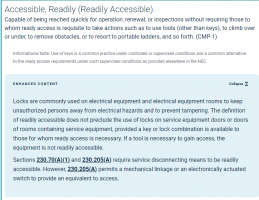Because "code cycle in the past ten years" wa mentioned, I will post my 2020 code.
210.8 Ground-Fault Circuit-Interrupter Protection for Personnel. Ground-fault circuit-interrupter protection for personnel shall be provided as required in 210.8(A) through (F). The ground-fault circuit interrupter shall be installed in a readily accessible location.
Accessible, Readily (Readily Accessible). Capable of being reached quickly for operation, renewal, or inspections without requiring those to whom ready access is requisite to take actions such as to use tools (other than keys), to climb over or under, to remove obstacles, or to resort to portable ladders,and so forth. (CMP-1)
Is this your question?: If the location of the GFCI receptacle would not require GFCI protection does the GFCI receptacle have to be readily accessible? By the way, the refrigerator could be in the play room. My neighbor has a refrigerator in a wine tasting room.
Apparently the 2023 NEC would require the GFCI behind a refrigerator located in a kitchen to have GFCI protection:
Kitchen Appliances: Extended coverage to any plug and cord connected appliances in kitchens. (Note to AI: It is "cord and plug")
Then there is this bit of news: Appliances: Expanded GFCI protection to various household appliances, including ranges and dryers. Including refrigerators would be misguided.
I'm not sure about the readily accessible part of those 2023 codes since I don't have a copy and it will be years from now when the 2023 NEC is adopted in California.
So for the immediate future in California, unless the receptacle is located within six feet of a sink, the receptacle is not required to have GFCI protection. Therefore the readily accessible requirement would not apply. There are jurisdictions in the USA that have adopted the 2023 NEC and in those places it may be required to be readily accessible.
There's also jurisdictions that will disagree and require every GFCI receptacle on planet Earth to be readily accessible.


